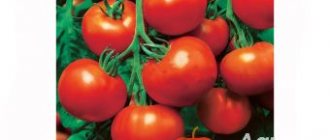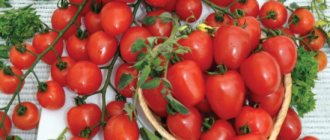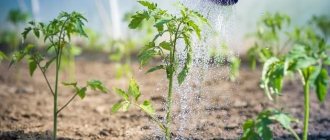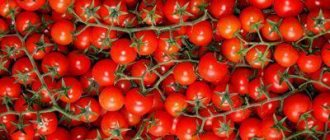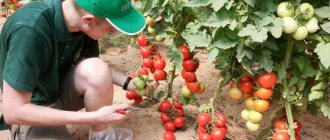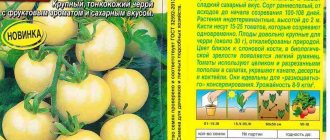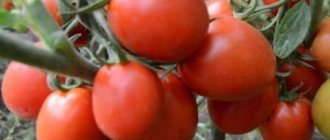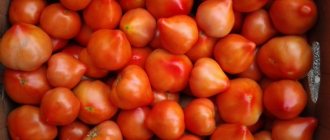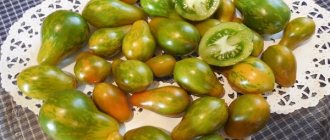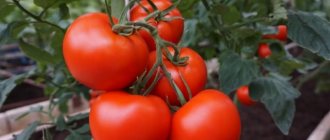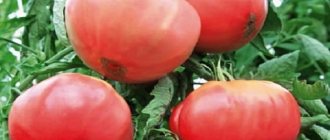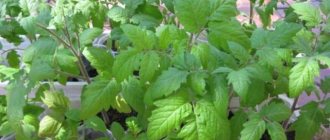Cherry Blossam f1 is a popular tomato originally from Japan. Included in the State Register in Russia in 2008. Like all crumbled tomatoes, it has an original sweetish taste.
| Height | Landing location | Ripening time | Fruit color | Fruit size | Origin | Fruit shape |
| Medium height | Greenhouse, Open ground | Mid-early | Reds | Small | Hybrid | Round |
General information
The Blossam Cherry hybrid is a determinate variety, which greatly simplifies its care. Height is approximately one meter. However, the central stem of these tomato bushes is thin, so they have to be tied to supports and pinched
Sweet fruits, according to reviews from summer residents, taste excellent not only fresh, but canned too. They are also suitable for preparing sauces, seasonings, juices, and ketchups.
The first ripe fruits are harvested 110 days after sowing the seeds for seedlings.
The yield of this hybrid, taking into account the very small size of the fruits (see photo), is quite high. With simple care, you can harvest up to 4.5 kg of delicious tomatoes from one square meter of plantation. Such yields occur both when growing new products in greenhouses and in open areas.
What is very important for us is that Cherry Blosem f1 tomatoes can be grown in all climatic zones except the Arctic. However, it was initially assumed that in our country the variety can only be planted in the North Caucasus, Kuban and Stavropol region
Practice, fortunately, has shown something completely different. Even in areas with short and cool summers, at least 95% of the fruits of this hybrid have time to ripen.
Terek F1
According to reviews from gardeners and summer residents, the Terek F1 hybrid is the most delicious of the cherry tomatoes, which has no equal in sweetness. The culture produces large yields. The fruits are collected in long clusters of 15 pieces. Each tomato weighs about 20 grams. The bushes are tall and require staking to supports.
The hybrid variety is suitable for cultivation throughout the country. In the middle zone and southern regions it can be planted in open beds. In the north, Terek F1 is successfully cultivated in closed heated greenhouses.
Tomatoes can be frozen, canned, and used for preparing first and second courses.
The hybrid "Terek F1" is sown for seedlings in the Rostov region and Krasnodar region at the end of winter.
About the Cherry tomato variety
The homeland of the species is considered to be South America and Peru. Now you can already find these tomatoes in our garden plots. Moreover, they are all different shades and shapes.
Peru is the official birthplace of the cherry tomato
Description of the variety
Varieties of this species can be of different heights from 358 cm to 2 m in height. The stems are elastic green. The leaf blades are green and have the usual tomato shape. Fruits may vary in color:
- Red;
- Burgundy;
- Yellow;
- Lemon;
- Green;
- Amber.
The shape of the fruit is round, oval, highly elongated elliptical.
All Cherries have a small berry weight of 15-35 g. depending on the variety.
Characteristics of Cherry
Feature of Cherry: even with good care, these tomatoes have lower yields than ordinary ones. However, they are much more attractive in appearance and contain a lot of sugar - 12%, which makes them popular in cooking.
These factors are the advantage to plant 5-6 cherry bushes on your site.
Cherry Blossom fruits
A characteristic feature of this variety is that its fruits are the same in size. Their weight ranges from 18 to 25 grams, as indicated in the description for them. The pulp is tight, rich in sugars. The share of dry substances in the pulp of Cherry Blossom tomatoes accounts for 6% of the total mass.
The skin of tomatoes is thin, but dense enough so that you can safely transport the crop over long distances and keep the fruit fresh for a whole month, without forced cooling.
The most popular cherry varieties for open ground
This type of culture is widespread among summer residents. Over the course of its existence, a number of species have been identified that are most often grown on plots.
Red
Tomatoes ripen early. The first fruits are picked on the 90-100th day. The type of bush is indeterminate, when growing it is necessary to carry out:
- formation;
- garter to supports;
- removal of the growth point.
The implementation of other agricultural techniques does not differ from other varieties.
Ira
After planting, 85-90 days pass, and the tomatoes bear their first fruits. The bushes are small, the maximum height of the bush is 1 m. Fruiting is long-lasting, which is why they love the Ira variety. Red tomatoes, small size, 30 g. It is necessary to tie up and control the number of shoots. Grow the plant in 2-3 stems.
Fingers
Refers to hybrid representatives of culture. It has positive characteristics for which summer residents appreciate the species:
- resistance to cold;
- drought resistance;
- high yield volume;
- stress resistance.
The tomatoes are not large, the bushes are small. Fingers are suitable for growing on loggias and balconies.
Sweet Cherry
When grown in favorable conditions, ripening begins after 2.5 months. The fruits are yellow and small in size. Children especially like them because of their sweet taste. Bushes produce fruit under stressful growing conditions. Some tomato lovers practice planting on the windowsill.
Strawberry
The first fruits ripen on the 100th day after planting. The bushes are determinate, so they do not require special care. Plants reach 1 m in height; staking to a support is recommended. The fruits are collected in clusters; with proper care, up to 25-30 red tomatoes are formed per 1. Strawberry is often used to decorate a site.
Dr. Green Frosted
The peculiarity of the variety is the shade of the fruits; they are emerald in color. The weight is small, 25-30 g. The taste is excellent, the tomatoes are very sweet. Tomatoes ripen in bunches, one produces from 7 to 10 fruits. The disadvantage of this variety is that it is difficult for a beginner to quickly determine the degree of ripeness of the fruit.
Required techniques:
- garter;
- formation;
- optional removal of the growth point.
Exotic fruits decorate the holiday table.
Ocean
Italian representative of cherry tomatoes. Fruit clusters consist of 10-12 tomatoes. They are red, weigh 20 g each. You cannot leave the bushes without shaping, this way you get more yield from larger tomatoes.
Date yellow
A hybrid characterized by enviable immunity and the ability to bear fruit in stressful situations for plants. Tomatoes are medium-sized, yellow. The taste is sweet, without the sourness characteristic of fruit culture. Plant height is 0.9-1.5 m. Healthy tomatoes are used for canning and preparing various salads.
Cherry Blossam F1
Like other hybrids, tomato is hardy and resistant to unfavorable growing conditions. The plants are medium-sized, reaching 110 cm. The fruits are red, tasty, sweet, weigh 15-25 g. Summer residents recommend tying up the plants, the stem is fragile and often breaks off.
Elf
It is demanding to care for, as it requires proper formation of 2-3 stems. In this case, a high yield volume and a larger size of tomatoes are observed. Red tomato, drop-shaped. Harvest immediately after ripening, as overripe fruits crack and fall off.
Amethyst cream-cherry
Summer residents advise not to plant bushes if the size of the plot allows. This is a rare type of cherry; at ripeness its fruits are creamy. The shoulders have anthocyanin stripes that are so close together that they appear to be a solid tone. The height of the bushes is 2 m.
Green grapes
Ripening occurs in 150-180 days. Tomatoes are green, sweet and tasty. When ripe on some bushes, the fruits acquire a golden hue. Summer residents advise consuming them fresh.
Margol
The peculiarity of cultivation is that they form into one stem. Tomatoes weigh 20 g; there are 15 to 20 of them in one bunch. Used for any cooking method, especially when whole canning, since tomatoes do not crack during processing.
White nutmeg
High immunity and productivity have made the tomato popular among summer residents. The fruits are yellow, all 40 g. Used for any processing method.
Dark chocolate F1
These productive varieties were bred in 1990 by Russian breeding scientists. “Cherry” is intended for cultivation in garden beds and under cover. The crop grows well in climatic conditions:
- central Russia;
- Krasnodar region;
- Rostov region;
- Stavropol Territory;
- Chechnya.
Yellow and red cherries ripen in 90-100 days. The height of the average trunk of the bush reaches 1.5-2 m. Miniature bright red fruits are collected in clusters of 25 - 40 pieces. The weight of one vegetable is 15-25 grams.
Black, red, yellow cherries are sweet varieties that, in addition to good taste, have an attractive appearance. They are grown for consumption raw. Black cherries have the same characteristics, the only difference is the exotic color of the fruit.
The tomato is recognized as suitable for cultivation throughout the country. The culture grows like a vine. The bush must be tied to supports and shaped. A good harvest is obtained on fertile soils with regular watering. With proper care, one plant produces up to 5 kg of tomatoes.
Seeds are sown in the ground from late March to early May. The timing of sowing depends on the climate of the growing region.
Tomatoes have a red-brown color. The skin around the stalk has a greenish tint. Tomatoes are formed in clusters of 10-12 pieces and have a sweet and fruity taste.
The size of the tomatoes is small - weighing from 20 to 30 grams. The vegetable is suitable for preparing first and second courses, eating raw, and canning.
Hybrid created in Russia. Tomato Date yellow has a pronounced fruity flavor. The culture grows well in warm regions of the country.
Medium-sized bushes grow in open ground from 90 to 120 cm. In shelters the plant reaches 150 cm in height. The harvest ripens in June-July.
Yellow tomatoes weighing 20 g. have an elongated shape and juicy sweet flesh.
Like all hybrids, this cherry tomato is resistant to infectious diseases of nightshades. The plant tolerates hot southern climates and rainy weather well.
Yellow and black varieties
Black and yellow varieties are sweeter than red or pink ones. Lisa, Ildi, whose cluster produces up to 100 fruits, and Kira are the best yellow high-yielding cherry tomatoes. They are similar to sea buckthorn berries. Kumato is a black raceme variety, bred either in Morocco or Belgium. Note that yellow tomatoes look like a ray of sunshine in a canned assortment. And a black cherry will add an exotic appearance to the salad.
Yellow and black tomatoes are healthier and contain fewer calories than red ones. The average calorie content of yellow vegetables is 25 kcal per 100 g. A miniature black cherry contains no more than 23 kcal, but this is an average calorie content.
Bush care
After planting, tomato bushes will require the following care:
- Plantings are watered regularly, twice a week. For irrigation, it is advisable to use water whose temperature is +20…+22 degrees. To water 1 m2 you will need from 3 to 5 liters of water;
- Once a week, the tomato is fed using mineral complexes or organic fertilizers enriched with potassium and phosphorus salts;
- They also carry out timely hilling as soon as the first tubercles appear on the stem near the soil;
- The bush needs to be tied up and stepsoned. It is recommended to remove all shoots below the first ovary.
Care
For tall varieties, a vertical support is required, to which the whip is tied as it grows. Stepping is carried out if many additional shoots grow. Some varieties require it.
When pinching, do not confuse a real leaf with a shoot. If you cut off the leaves, this will affect the fruiting of the bush.
Like all tomatoes, cherry tomatoes love airing; this helps pollination and prevents moist air from stagnating with unwanted microorganisms.
Watering and fertilizing
Cherry tomatoes like daily moderate watering. If this is not done, brown cracks will appear on the fruits. As a result of excessive watering, they will become watery and may also crack. Watering is done with warm water.
Tomatoes love complex mineral fertilizers containing not only phosphorus and potassium, but also modybdenum, zinc, iron, magranium, selenium and cobalt. It is difficult to make such a mixture on your own.
There is a wide range of such fertilizers on sale. The most commonly used are Agricola and Effecton. Experts recommend the Kemira mixture as the most balanced in composition.
Tomatoes are fed once a week after transplanting into the ground. During the formation of ovaries, ammonium nitrate with the addition of wood ash is added.
If the bushes begin to grow, but the fruits do not ripen, then it is necessary to reduce or temporarily eliminate fertilizing with nitrogen fertilizers. feed them with potassium sulfate
Fertilizing must be combined with watering.
Working with soil
It is advisable to mulch the soil under cherry bushes with sawdust, straw, manure or agricultural canvas. This will prevent the fruits from coming into contact with the ground and will help avoid their rotting and infection with fungal diseases. In addition, this will protect the soil from overheating.
Cherry tomatoes require regular loosening and weeding.
Gardeners often use a simple technique to prevent tomato diseases. They are grown in metal buckets, which various pests do not like. Buckets can be dug into the ground, or simply placed in a garden bed or greenhouse.
Peculiarities
The name of this tomato is translated as “cherry”, but this does not mean that all the fruits have the appearance of a cherry. Breeders have bred a large number of hybrids that have different fruit shapes and colors. On the market you can find tomato seeds with striped fruits. A distinctive feature of cherry hybrids is the fruit weight is 10-35 grams.
The structure of the ovaries in different varieties differs in shape, for example:
- like bunches of grapes;
- long, symmetrical lashes;
- small brushes, on which no more than 7 fruits are formed;
- single tomatoes located on the bush from root to crown;
- umbrella-shaped tassels like those of viburnum.
Low growing tomato varieties
This category of tomatoes is preferred in regions where outdoor cultivation is used. When planting above tomatoes, it is easier to build shelters from frost.
Ildi F1
Reaches a height of 1.8 m. The tomatoes are very small, weighing 15 g. Up to 60 pieces are formed on one brush. The yellow fruits are used in home canning. A peculiarity of maturation is that on one hand the following is simultaneously observed:
- ovary;
- flowers;
- ripening and ripe tomatoes.
Foreign exchange
Pruning is necessary, since the plant is determinate, there is no need to pinch. The bush itself stops growing. Able to form ovaries under unfavorable growing conditions.
Biathlon
The disease-resistant hybrid is familiar to many summer residents. The bushes are small, 0.8 m in height. The whole vegetable is often used for canning. Summer residents advise growing this hybrid for winter preparations.
Cranberries in sugar
0.6 m in height, such bushes do not need shaping or staking. The fruits are small, weighing up to 15 g. They are grown in any way, not only in open ground, but also in greenhouses, on balconies and boxes on the street.
Granddaughter
The fruits are larger than those of other types of cherry, maximum weight is 50 g. But the bushes support the weight on their own, without needing to be tied to supports. The granddaughter has average immunity and is undemanding to the composition of the soil.
Honey candy F1
The hybrid bears its first fruits after 3.5 months. They are yellow, medium-sized and sweet. The bushes are low, reaching up to 1 m. It is not difficult to care for such plants. It is enough to carry out agricultural techniques in a timely manner.
Coin
Low plants, which barely reach 0.4 m in height, are loved by summer residents for the taste of their fruits and decorative properties. After 3 months they try the first tomatoes.
Tomatoes:
- weigh 15 g;
- shade yellow;
- taste sweet;
- universal application.
Tomato Children's sweet
Ripens early, forms yellow tomatoes weighing 30 g. Bushes size 0.7-1 m. Care is the same as for other varieties of crops. Plants do not need pinching or staking.
Florida Petite
The variety adapts to any growing conditions. Always produces a bountiful harvest of delicious red tomatoes that are not sour in taste. Housewives use vegetables for any purpose, from processing to winter storage.
Pink raisins
The tomato variety was obtained thanks to the work of Ukrainian breeders. Their goal was to create the most productive type of tomatoes, which would be unpretentious in growing and transportation conditions. And they succeeded.
Interesting! One of the disadvantages of the variety is the high risk of late blight. Summer residents who decide to grow Pink raisins are advised not to neglect spraying the crop with special solutions.
Pink raisins are a determinate plant. The height of the bush does not exceed 150 cm. The main feature of the variety is its rapid growth, rapid ripening of fruits and productivity. The largest number of tomatoes is observed at the base of the stem, and towards the top there are fewer of them. From one bush you can collect from 5 to 6 kg.
Characteristics of a medium tomato variety “Pink Raisin”:
- The shape is oblong, resembling a plum;
- Length – 5 cm;
- Weight – 70-75 g;
- The peel is thin, light green in color, sometimes with a pearlescent tint.
During the ripening process, the surface of the tomato does not change and remains smooth; scales or cracks do not form on it. Pink raisins have a delicate, sweet taste. It is often chosen for canning and preparing salads.
Tomatoes of this variety differ from others in their long shelf life and elasticity of the peel. Picked unripe fruits can be kept in a dry room away from sunlight for about six months. During transportation, they practically do not crush and are not damaged when hitting the walls of the box.
Features of agricultural technology
Cherry tomatoes are one of those plants that, without proper planting and care, will not be able to produce a rich harvest, so the gardener should adhere to the basic rules and advice regarding agricultural technology for growing this crop.
Find out from the video what to do to fully ripen a bunch of cherry tomatoes, what agricultural technology to use:
Growing seedlings
Quick and competent preparation of seedlings is the key to a high-quality and juicy crop harvest. For seedlings, cherry seeds are placed in the ground in March.
Basic rules for the growth of healthy seedlings:
- Place planting material only in nutritious and breathable soil.
- To ensure seedlings grow at the same time, cover the seed pots with glass.
- The temperature in a greenhouse with seedlings should be at least +27 Celsius.
- Seedlings should be illuminated; if there is not enough natural light, use phytolamps.
- Prepare the planting site in open soil or greenhouse in time.
Substrate for seedlings
The soil for this type of tomato must be fertile, and this applies not only to pots of seedlings, but also to open soil. To improve it, add nutritional supplements. The easiest option is to go to the store and buy a suitable mixture, but it is better to make it at home with your own hands.
The cherry mixture consists of:
- turf soil;
- soil from the garden;
- peat;
- sand.
Be sure to disinfect the substrate for planting the planting material. Use a weak solution of potassium permanganate or put the soil in the oven for a quarter of an hour.
Features and timing of planting
So that you can enjoy cherry fruits in the first days of summer, plant the seed in the soil in the last week of February or early March.
Plant tomatoes in 12 cm containers, do not forget to provide shelter. 5 days after planting, the seedlings will begin to hatch, remove the glass
When 2 plates appear on the seedlings, carefully pick the plants into different cups. Cherry tomatoes grow in separate pots before transplanting to the main place
Planting seedlings in open ground
Fully formed seedlings look like this: green leaves, height about 0.2 m, stem thick and strong. You cannot immediately transplant seedlings into indoor or open ground, otherwise the plant will not withstand the climate and weather and will die.
Carry out hardening 10 days before transplanting seedlings. At first, the sprouts are taken out into the fresh air for about 2 hours, then the amount of time is increased and on the 8-9th day they can be left overnight.
Dig holes in open ground and place a small portion of wood ash in them, water and plant seedlings. After this, cover the sprouts with soil and tamp it down a little. If the climate in your area has returned to normal, you can mulch the sprouts. To do this, use straw, hay or dried grass.
Transplant the seedlings on a cloudy rainy day, or better yet, in the evening. This method will help the plants establish themselves faster and better in the ground.
This video talks about the experience of growing cherry tomatoes in open ground:
Description of the American tomato Cherokee Green golden and growing in seedlings
The Cherokee Green golden tomato was bred by US breeders in 1997. This is a rather rare variety for Russia, colored brown, green and gold. The Cherokee Gold tomato does not crack from mechanical stress, despite the fact that the tomato has a fairly thin skin.
It can be grown in open ground only in the southern regions of Russia, and in the open spaces of the middle zone and in the northern regions of the country, greenhouses and hotbeds have to be used. The tomato variety described is not intended for transportation or long-term storage, so it is consumed fresh, salads and tomato juice of unusual colors are made from it.
Technical data of the variety
The characteristics and description of the plant are as follows:
- Cherokee Green Gold belongs to the group of tomatoes with medium ripening periods. The vegetative period of development lasts up to 130 days - from seedlings to the first harvest.
- The height of the plant bushes ranges from 160 to 180 cm. A bush is formed from several stems, on which many leaves are formed, colored green and evenly spaced along the tomato trunk.
- Cherokee Green has practically no branches in width. All the plant's energy goes into growing the bush. From 4 to 5 clusters develop on the stem, which produce 5-6 fruits.
- Tomatoes of the described variety have the shape of a ball flattened at the top and bottom. The weight of the fruit ranges from 0.3 to 0.5 kg. The ripe berry is colored brown and yellow on the outside, and green (emerald) on the inside, with a small number of seeds. The surface of the fruit is shiny, with clearly defined ribs. The pulp is aromatic and contains a lot of juice.
- The harvest can be harvested throughout the summer. The first berries ripen approximately 117-127 days after the seedlings appear, and then the plant bears fruit throughout the summer.
Reviews from farmers growing this variety show that tomato yield ranges from 3 to 7 kg of berries per bush. Gardeners note that when sown in open areas, the first fruits can reach a maximum weight of 400-500 g, and the weight of subsequent berries is reduced to 0.15-0.3 kg.
When growing the described tomato hybrid in a greenhouse, gardeners receive berries of the same weight, the average weight of which ranges from 250 to 300 g. Farmers consider the disadvantage of the variety to be the need to harvest stepsons and install supports under the branches of plants.
Growing seedlings in your own backyard
To obtain a high yield, the correct biotechnology for planting and growing Cherokee Green must be used.
Seeds are disinfected in a solution of potassium permanganate. They are then soaked in water to swell. Floated specimens are thrown away. Planting material is planted in boxes or separate cups filled with soil for tomatoes. The container with seeds is installed in a warm, well-ventilated area.
When the first shoots appear after 7 days, they are watered with warm water and fed with manure or peat.
Before planting seedlings in the soil, loosen the ground, apply complex mineral fertilizer (no more than 1 tbsp) to each bush. The format for planting bushes is 0.5 X 0.5 m, each bush is formed from 2-3 stems. The lower leaves need to be torn off, as they immediately begin to dry out.
Self-care for tomatoes
When flowering, plants are fed with superphosphate and potassium sulfate. During fruit formation, the bushes are fed with magnesium sulfate, pouring the solution under the root.
Cherokee is watered only during severe drought. To do this, use water at room temperature. It is necessary to ensure that the liquid does not wash out the root system of the plants, otherwise up to 30% of the harvest will be lost.
Loosening is carried out 1-2 times a week. You can mulch the soil so that all useful microelements and moisture are retained in the soil. The gardener must weed the beds once every 2 weeks.
Although Cherokee Green is immune to all diseases, it is recommended to carry out preventive spraying of the bushes with medicinal preparations. If the farmer has treated the seeds with pesticides, then there will be no need to use any additional products. This measure will also save the plants from damage by the Colorado potato beetle.
When aphids, mites, and caterpillars of various insects appear on tomato leaves, they are destroyed with toxic chemicals.
Features of the variety
The original name of the tomato variety is Red Cherry. This is an early ripening variety of indeterminate type. The period from the moment of germination to the full ripening of the fruit is from 95 to 100 days.
Description of the variety:
- bush height from 120 to 180 cm;
- Long brushes strewn with small tomatoes give the plant a special attractiveness and decorative appearance;
- from 20 to 40 berries are formed on each brush;
- yield - from 1 to 6 kg per 1 sq. m;
- Tomato has increased resistance to fusarium and verticillium.
Fruit characteristics:
- round, smooth shape;
- weight from 10 to 20 grams;
- the skin is soft and dense, does not crack;
- bright red tomatoes;
- the flesh is fleshy and juicy;
- Due to the increased sugar content, tomatoes have a sweet, dessert taste;
- They are stored for a long time and are resistant to mechanical damage during transportation.
Red cherry tomatoes are intended for whole canning and fresh consumption, and are also ideal for decorating various dishes.
Description and characteristics of the variety
Cherry Blosem f1 is a standardless hybrid with medium-sized bushes. The shoots grow to a maximum height of 1 m. Up to 20 tiny tomatoes are formed on the fruiting clusters. Average weight 20-25 g.
The ripening period is mid-early - 95-110 days from the moment of germination. The tomato is intended for planting in greenhouses and open areas.
Tomatoes are bright red, round in shape. The skin is durable. The pulp is juicy, sweetish with a slight sourness. The number of nests does not exceed 2, the dry matter level is 6%.
Growing and care
Indeterminate hybrids are considered the most suitable for indoor soil. Greenhouse tomato cultivation involves sowing seeds for seedlings. The algorithm of actions is as follows:
- sort out the seeds;
- pour a weak solution of potassium permanganate for 5 minutes;
- rinse with clean water;
- place on a damp cloth for germination;
- sow seeds in seedling boxes.
Plants are planted in a greenhouse as soon as the period of night frosts has passed - early or mid-May, depending on the region.
To prevent the planted plants from getting sick, the greenhouse must be constantly ventilated.
Two weeks after planting the plants in closed ground, you need to tie up the bushes and begin to form bushes. To get a good harvest, you need to know some of the nuances of caring for cherry tomatoes:
- Not only tall plants are tied up, but also small bushes. Since tomato brushes can fall to the ground and rot.
- Many types of tomatoes of this variety are not resistant to fruit cracking, so you should strictly follow the watering system.
- If the daylight hours in the region are short, then it is worth arranging plant lighting - cherry is a light-loving plant.
You can also watch a video where an experienced gardener will reveal the secrets of growing cherry tomatoes.
Many gardeners like to grow the Cherry tomato; the ornamental appearance of the bushes and excellent taste make this crop popular and in demand. Another advantage is the fact that this plant feels great on the windowsill and can delight you with fresh fruits all year round.
Optimal growing conditions
To get a good harvest, it is recommended to place the Lyuba cherry tomato on the garden bed subject to the following conditions:
- The soil composition is neutral or slightly alkaline. Tomatoes will not grow in acidic soil. If necessary, the composition is neutralized in the fall with lime or dolomite flour.
- The soil is aerated, enriched with organic matter and microelements (ideally black soil). Loams and sandstones are improved by adding peat and compost.
- Constantly waterlogged soil is not suitable for tomatoes. If necessary, drain groundwater.
- Choose a bed without shade; tomatoes should grow full daylight in full sun.
- Crop rotation is observed; tomatoes are not placed in one bed for more than two seasons.
Important! In temperate climates, the Lyuba cherry hybrid is cultivated only in greenhouses, in the South - in open ground
Tomato Cherry Blossom
Mid-early (90-100 days from germination to ripening), determinate tomato hybrid from Sakata (Japan). Recommended for growing in open ground and film shelters.
The bush is powerful, medium-sized, up to 1 meter high, requires tying to a support and pinching. Medium sized leaf, green. The inflorescence is complex. The best results were obtained when forming a plant with 3 stems.
Fruit characteristics
The fruits are round, smooth, dense, not prone to cracking, red in color at maturity, weighing 20-30 grams, sweet, very tasty. Thanks to their durable skin, which is resistant to cracking during heat treatment, these tomatoes are suitable not only for fresh consumption, but also for whole-fruit canning.
The hybrid has high disease resistance: resistant to verticillium wilt, fusarium wilt, nematodes, Alternaria blight, tomato bacteriosis, brown spot, tobacco mosaic virus.
The seeds are treated with the fungicide Thiram. Do not soak when planting!
Agricultural technology for growing Blossem cherry tomato
Sowing seeds for seedlings is carried out in cassettes or seedling boxes. At a temperature of +20+22 degrees, seedlings appear on days 5-7.
When the 2nd pair of true leaves appears, the seedlings are picked, transplanting the plants into separate pots. During the growth period, seedlings must be regularly fed with mineral and organic fertilizers. When planting ready-made seedlings in the field, complex fertilizers are added to the hole.
During the growing season, tomatoes are fed several times.
In some catalogs this variety is called Cherry Blossom.
If you have grown Blosem cherry tomatoes, please write how you rate this hybrid. What was the yield and taste of the fruits like under your climatic conditions? Briefly describe the advantages and disadvantages of this tomato in your opinion. If possible, attach to your review a photo of the entire bush or individual fruits you grew. Thank you!
Your reviews of the Blosem cherry tomato and additions to the description will help many gardeners evaluate the hybrid objectively and decide whether it is worth planting or not.
Agricultural technology of tomatoes Blosem F1
Growing Cherry Blossom tomatoes does not differ from the standard, except for the obligatory formation of a bush.
Growing seedlings
The hybrid Cherry Blossem is grown mainly through seedlings; sowing in open ground is advisable only in the southern regions of the country. Seeds purchased from a responsible distributor are treated with Thiram by the manufacturing company. Such seed does not require any soaking or other processing. An excellent option is to plant grains in ready-made peat tablets. Or the seeds are sown in a substrate consisting of equal parts of garden soil, sand and humus.
Crops are visible after 5-7 days. The container with the sprouts is transferred to the light, in a room where the heat does not rise above 20 °C, for a week. Then favorable conditions are created for the strengthened tomatoes:
- temperature 23-27 °C;
- additional lighting up to 14 hours a day;
- moderate watering.
With the appearance of 2 true leaves, the plants are planted in individual containers, maintaining the same care regimen. 10 days after diving, the tomatoes are fed with complex fertilizer for seedlings.
Landing rules
Cherry blossom tomatoes with 7-9 leaves and the first inflorescences, after 50-60 days of growth, are transplanted to a permanent place. If the seedlings are taken out into the garden and not into the greenhouse, they are hardened off for 12-14 days. The determinate variety is placed according to a 45x50 cm pattern. A tablespoon of ammonium nitrate is added to each hole.
Watering and fertilizing
The soil on the site is regularly moistened:
- watering is carried out with warm water in the evening;
- water the soil in the root area without moistening the stem and leaves;
- each tomato bush is provided with up to 5 liters of water;
- in dry weather, water 3-4 times a week;
- if precipitation is heavy, stop watering;
- in the greenhouse they water 1-2 times a week, taking into account that the air humidity for tomatoes should not exceed 70%, and the soil should be moderately moist.
The best fertilizers for the Blosem hybrid are balanced mineral fertilizers. Tomatoes are fed once every 15-20 days. Foliar feeding with boric acid and potassium permanganate is effective.
Advice! Before fertilizing, water the soil or apply fertilizer after rain.
Pinching and tying
The shoots that appear in the axils of the leaves, after the first inflorescence, are cut off every 7-10 days. The stepsons are removed if they have reached 4-5 cm. At the same time, the stem is tied to a trellis.
Attention! Tomatoes are planted on a fine day, a week after fertilizing. The plant is under stress and will have few resources to absorb minerals from fertilizers
Formation
In determinate varieties, the main crop is planted on the central stem - up to 4-5 inflorescences. For the Blosem tomato, it is recommended to grow a bush with 3 stems, forming additional ones from the lowest stepsons. Determinate tomatoes are sometimes pinched back in August so that the fruits from the upper branches can fully ripen at approximately the same time. For those bushes that grow in a greenhouse, they provide ventilation and save nutrition by tearing off all the lower leaves up to the first cluster.
Protection from diseases and pests
The Blosem variety is not affected by a number of fungal and viral diseases. Plants are resistant to:
- fusarium;
- verticillium;
- Alternaria;
- cladosporiosis;
- bacteriosis;
- tobacco mosaic virus.
In addition, the root system of the variety is not susceptible to infection by nematodes. For late blight, preventative treatment of tomatoes with fungicides is carried out immediately after planting. Adhering to the correct agricultural technology, thereby protecting the bushes from whiteflies.
Growing and care
After reading the reviews, you can find out that Red cherry tomatoes have been grown for many years not only in Russia, but also in neighboring countries. The variety is recommended for cultivation in greenhouses and tunnel-type film shelters, as well as in open ground. Agricultural technology:
- Sowing seeds for seedlings is carried out from early March to mid-April. The substrate for sowing cherry tomatoes can be used ready-made from the store or prepared yourself. To do this, you need to take equal parts of turf and garden soil, sand and peat.
- The prepared soil must be disinfected: poured with a bright pink solution of potassium permanganate or calcined in the oven for 20 minutes at a temperature of 200 degrees.
- In the prepared soil, make grooves 1–1.5 cm deep and place the seeds in them. Then sprinkle soil on top and pour plenty of warm water.
- Cover the containers with film and place in a warm place. The optimal temperature for germination is +25–28 degrees.
- The room temperature should be maintained within +20–22 degrees, and the tomatoes should be provided with additional lighting. This way the young shoots will not stretch out and become thinner.
- The best predecessors for tomatoes: dill, carrots, parsley, zucchini, cucumbers and cauliflower.
Features of care
Growing cherry tomatoes is practically no different from cultivating their larger counterparts. But there are a number of features that need to be taken into account when planting babies:
- Cherries are grown exclusively by seedlings. Seeds are planted in pots in February-March. Strong seedlings are transferred to hotbeds or hothouses in April-May, and to open beds only with the onset of stable heat.
- The basic planting pattern is 50cmx50cm. For 1 sq. No more than 3-4 plants are placed per meter.
- Plants are planted as needed.
Tall bushes are formed into 1 or 2 stems, the 2nd stem is obtained from the 1st stepson. Above, additional branches are left as needed, taking into account the load on the bush - if the main brushes are heavily loaded with fruits, then the stepsons should be removed. If there is not enough fruit in the main clusters, some of the additional branches can be saved. Low-growing cherry varieties usually do not require pinching. Simply remove all leaves and shoots up to the first bunch of fruit. - Absolutely all varieties (both tall and short) of cherry trees require gartering of trunks and brushes to a support. This is due to the length (up to 1 m) of the fruit clusters. Fixing the bush allows the trunk not to break under the weight of the tomatoes and to avoid the tomatoes coming into contact with the ground.
- It is necessary to pick fruits from the plant only in the phase of full ripeness. Semi-ripe tomatoes, when ripened outside the bush, partially lose their taste.
- Water the plants daily. Sufficient moisture ensures the integrity of the tomato skin.
- Cherries bear fruit for a long period. You can enjoy the fruits in heated greenhouses until the New Year.
Gradation of cherry tomatoes
The large family of cherry tomatoes can be divided into several categories.
Similar to their large-sized counterparts, depending on their height, they are usually divided into:
- Dety (low-growing or determinate varieties);
- Semi-children (medium-growing or semi-determinate varieties);
- Indets (tall or indeterminate varieties).
In the group of low-growing cherry varieties, the so-called superdeets are distinguished. Plants included in this category do not grow higher than 30-40 cm. Often these specimens are the most preferable for growing in pots placed on window sills and boxes placed on balconies.
In English, the word “cherry” means nothing more than a cherry. Depending on the size of the fruit, small-fruited varieties of tomatoes are divided into cocktail and cherry tomatoes. The former are characterized by fruits weighing 40-50 g. For the latter, this figure does not exceed 10-30 g.
Breeders never tire of developing new varieties of cherry tomatoes. Hybrid varieties are usually labeled with the abbreviation F1.
Amateur gardeners should remember the futility of collecting seeds of hybrid tomatoes that do not retain the parental characteristics.
You can purchase the seeds you like at specialized seed sales points. You can also place an order on the pages of the corresponding online stores. When purchasing a cherry tomato variety, you can limit yourself to choosing the most attractive fruit in order to remove the seeds and their further planting.
The abundance of cherry varieties on the market is amazing. The majority of seed companies operating in this area are ready to offer consumers several varieties of small-fruited tomatoes.
At the stage of choosing a suitable seed, it is advisable to study the advantages of the variety you like, taking into account the place where it is grown (greenhouse, balcony, garden plot). You are welcome to familiarize yourself with the recommendations on agricultural technology.
Tall varieties are bred for greenhouse cultivation. The marks “for loggia” and “for balcony” indicate that the variety can be used for home cultivation.
The time spent at this stage will not be wasted. As practice shows, it is not possible to provide tall cherry tomatoes with sufficient food and light in apartment conditions.
Varieties of cherry tomatoes
Small-fruited tomato varieties represent a large group, the representatives of which differ from each other in several characteristics:
- fruit shape and color;
- bush height;
- inflorescence structure;
- ripening period;
- growing method.
Despite the fact that cherry got its name due to its resemblance to cherries, not all varieties resemble this berry in shape. You can find varieties of pear-shaped, oval or elongated shape. One of the common characteristics of small-fruited tomatoes is the weight of one tomato. At the stage of technical ripeness, cherry tomatoes weigh between 10-30 g.
Most varieties are indeterminate. In greenhouses, the height of shoots reaches 2 m or more. But there are varieties with compact bush sizes suitable for growing in containers. Low-growing cherry trees are planted on balconies, loggias and window sills. The small size of the root system makes it possible to grow tomatoes in conditions of limited soil volume.
The structure of fruit clusters also depends on the variety. Miniature “cherries” can be collected in clusters reaching 1 m in length or located on short branches of 4-5 pieces. Some cherries are covered with single fruits. Moreover, a distinctive feature of all varieties is the simultaneous ripening of tomatoes on the branch. The period during which tomatoes have time to fully ripen ranges from 2.5 months for early varieties to 4-5 months for late varieties.
In addition to the listed parameters, cherry tomatoes differ in the method of cultivation. When choosing a variety, you should definitely take into account what type of soil a particular variety was bred for: open or protected.
Features of cultivation and storage
They are grown in the standard way - by seedlings. Seeds are sown in the 1st-2nd decade of March. They use purchased soil or prepare it themselves from turf soil, add peat, compost, wood ash, and sand.
The seeds are buried 1.5 cm, sprinkled with a layer of fine soil mixture on top and compacted.
Seedlings are cared for as follows:
- until germination, the boxes are kept warm under film;
- then hardened for 1 week at 14 degrees;
- fed with complex fertilizers – “Strong” or “Solution”;
- dive when there are 3 true leaves.
Ripe cherry tomatoes can be stored for up to 30 days. For preservation, choose cool, dark rooms without dampness or drafts.
Description of Cherry Negro tomato, cultivation and planting rules
Vegetable growers enjoy growing challenging and exotic types of tomatoes. One of the most popular is the Cherry Negro tomato. It attracts not only with its unusual appearance, but also with its excellent taste.
Small cherry tomatoes are great for canning, making vegetable salads and juices.
The Cherry Negro variety is classified as a dark variety, since the color of the fruits can range from dark burgundy to purple. These small-fruited tomatoes are early-ripening, tall-growing, and produce high yields.
Before you start growing Cherry Negro tomato, you should familiarize yourself with its characteristics and description. This will help to properly organize the sowing of seeds and further care of the plant.
Characteristics of the variety
Cherry tomatoes are indeterminate and tall plants. In greenhouse conditions, an adult plant can reach large sizes, but in open ground the bushes have a more compact appearance and are smaller in size. The plant needs staking and strong support.
The foliage of the Cherry Negro variety is dark green. The shape of the leaf is slightly elongated, medium in size. The branches are compactly and densely located throughout the bush, so an adult plant does not take up much space.
This variety requires pinching. You need to form a culture in 1 stem, removing all lateral shoots. At the end of the season, you should stop the growth of the bush yourself by pinching the top.
The variety belongs to a whole group of Cherry class tomatoes. The crop is grown in open ground, in greenhouses or greenhouses.
Each tomato weighs on average about 25-30 g. The color of tomatoes ranges from dark brown with a burgundy tint to dark cherry. The fruits are ovoid in shape. All Cherry Negro tomatoes are the same size, they ripen together and at the same time. The surface of the fruit is smooth and shiny, the stalk is rather short.
The early ripening tomato variety Cherry Negro allows you to get the first fruits 85 days after sowing the seeds. Tassels on the stem are formed immediately after the 7-9 leaves. The yield of this plant is high: 10-12 kg of fruit can be harvested from 1 m².
Cherry Negro tomatoes taste sweetish, the flesh is dense and juicy, with a subtle spicy aroma. The skin of tomatoes is thin, but quite durable. It protects fruits well from cracking. These small tomatoes can be stored for a long time in a cool room.
Experienced vegetable growers indicate that the Cherry Negro variety has good immunity to various diseases. It is especially resistant to late blight.
In the family of these varieties there is another worthy type of tomato - Cherry Negro Pragna F1. It has a distinct tomato flavor, but is complemented by spicy and sweet notes with a hint of fruit.
Cherry Negro Pragna F1 has a number of features that set it apart from the general group:
- the variety has larger fruits: on average, 1 tomato can weigh about 130-150 g;
- the shape is more elongated, with a sharp tip;
- small brushes;
- color almost black, with a purple tint;
- often formed into 2 trunks;
- growth activity is equally good both in the open air and in greenhouse conditions;
- needs regular feeding with high-quality fertilizers.
Negro and Negro Pragna tomatoes are grown in seedlings.
Growing and care
Seedlings are planted 45-50 days before planting in open ground. This is the end of April or the beginning of May. Sowing is carried out in a special container with pre-prepared soil, which consists of peat, river sand and ordinary soil.
As soon as 2-3 leaves appear on the sprouts, you can start picking. In early June, seedlings are planted in open ground. Before this, the soil is fertilized with humus and wood ash. No more than 3-4 plants are planted per 1 m². Immediately after planting, the beds are watered and mulched.
Further care is carried out as usual:
- regular watering;
- loosening the soil;
- fertilization and feeding;
- Preventive treatment of plants against pests.
The Cherry Negro variety has the most positive reviews from vegetable growers, since the plant is unpretentious in care, resistant to many diseases and produces a bountiful harvest.
Growing tomatoes
The Sweet Cherry hybrid is cultivated, like other tomatoes, through seedlings.
How to prepare seeds?
Before sowing, the seed material is disinfected in a pale manganese solution and treated with growth stimulants.
Sowing seed material
Description:
They start forcing seedlings in the last days of March - in the first ten days of April;
The seed is buried in moist soil at intervals of 1-2 cm. Sprinkled on top with a 5 mm layer of soil; To create optimal conditions, containers are covered with a film cover and the temperature is maintained within +24...+26 degrees;
After the shoots emerge, remove the film from the container and leave it in bright light. At the same time, the temperature is reduced to +12…+14 at night, and +16…+18 during the day
Water carefully, trying not to over-moisten the soil; With the appearance of the first pair of true leaves, tomato seedlings are planted in separate containers; The soil in the containers is kept moist and loose.
Seven days after picking, fertilizing with mineral fertilizer is carried out.
Rules for planting seedlings
Description:
- It is advisable to grow the tomato hybrid “Sweet Cherry” in greenhouses, but you can also plant unprotected soil, but only under a film cover;
- The distance between the bushes is approximately 50 cm, the row spacing is maintained at least 70 cm;
- It is advisable to choose a soil that is light and breathable. It is also fertilized with compost, wood ash, and mineral fertilizers. In clay soil it is necessary to add peat or sand.
Growing rules
The Betta tomato is propagated by seeds purchased from a retail chain.
Attention! It is not recommended to plant a tomato hybrid next to other tomato varieties. Cross-pollination can affect fruit size and fruiting rate
The variety is propagated only by seedlings.
Planting seedlings
Purchased seeds do not require disinfection against fungal disease; they are treated with the drug before sale. To speed up seedlings, it is recommended to immerse them in a growth-stimulating solution for 6 hours. It is necessary to prepare a planting mixture consisting of equal parts of turf soil, peat and compost. Work on planting seed begins in mid-March. The sequence of actions is as follows:
- Soil is poured into containers, boxes or any available container (at least 15 cm).
- Make a linear depression (up to 2 cm), evenly distributing the seeds at intervals of 1.5 cm.
- Water with warm water.
- Cover with soil and a layer of peat on top.
- Cover the container with future seedlings with a transparent, air-tight material (polycarbonate, glass, polyethylene).
Place in a warm room, out of direct sunlight. After germination, the covering is removed to provide access to oxygen. Apply complex fertilizer. Watering is carried out no more than once a week.
After the formation of the third leaf, the seedlings must be planted in larger containers or plastic cups. The best option, in order not to further injure the plant, is to transplant the plant into peat containers and distribute them into the garden bed.
Tomato transplant
The timing of planting the plant in the ground is determined by weather conditions; the Betta tomato variety is not afraid of low temperatures, but for normal growing season it is necessary that the soil warms up to +16 0 C; for the southern regions this is the beginning of May. In heated greenhouses, planting dates are adjusted according to the wishes of the vegetable grower. If the greenhouse structure is without artificially created heat, tomatoes are planted at the end of May.
The determinate variety is compact in width; 6 tomatoes can be planted per 1 m2. The interval between the crops is 30 cm, the row spacing is 60 cm. Organic matter is added to the previously prepared holes, the plant is placed vertically, deepened by 8 cm, and hilled. This measure will help maintain moisture and prevent damage to the roots from a possible drop in temperature.
Subsequent care for tomatoes
The low-growing variety "Betta" does not require fixation to a support or trellis. Tomatoes produce a minimal number of shoots, which do not need to be removed. Dry leaves will need to be removed periodically. Required care:
- Tomatoes do not tolerate waterlogging of the root ball; watering is done once every 10 days.
- Fertilizing is carried out in three stages: with organic matter during planting of seedlings, phosphorus agents at the time of flowering, and potassium fertilizers when the fruits ripen.
- Preventive treatment with copper sulfate is necessary.
Mulching is carried out with peat both in greenhouses and in open areas.
Features of cultivation
There are 2 ways to grow tomatoes:
- Seedling - seeds are planted in cassettes, peat tablets, wooden boxes or other containers in mid-March.
- Without seedlings - sowing in open ground (under film) at the end of April. This method is used only in the south.
An important feature is that there is no need to treat the seeds before planting, since the manufacturer has already treated them with the drug “Thiram”. You can first put it in a container with a solution of Epin or Zircon. Then plant it in soil: store-bought or your own (for example, from compost, humus and the surface layer of soil in a ratio of 1:1:2). Planting depth – 1 cm, interval – 2 cm, distance between grooves – 4 cm.
The soil is moistened, covered with film, and placed in a warm place (temperature above 24 degrees). Shoots appear after a week - at this time the shelter is removed and the temperature is reduced to 22 degrees. After the formation of 2-3 leaves, the seedlings are planted, then complex fertilizer is applied. 2 weeks before transplantation, they are hardened at a temperature of 15-17 degrees.
Tomatoes ripen together on a branch
Cherry Blossom tomatoes are transferred to the greenhouse in the second half of May. The planting pattern is in a checkerboard pattern, with the same interval between bushes and rows: 50 cm. Cultivation agricultural technology includes the following actions:
- Watering 2 times a week, 3 times during drought.
- Fertilizing with complex fertilizer – once every 3 weeks.
- Tying bushes to a support.
- Pinching, formation into 3 stems.
- Mulching, weeding, loosening the soil.
Advice! Cherry Blossom tomatoes are left to ripen on the bush. Moreover, after they reach a red color, they need to be kept on the plant for a few more days, but no more than a week - after that they become somewhat dry in taste.
Renet
Renet is recognized by gardeners as the most economical and productive. Some grow approximately 1,000 bushes on one acre of land. Renet grows quickly, but its fruits appear closer to the root. If you do not “pinch” the top of the bush in time, then this part of the plant will draw nutrients and water from the tomatoes, which is why they will be small and ugly.
Renet is an extremely early tomato. Its fruits resemble the De Barao variety in appearance. They are large, sweet, juicy, but have a thick skin, which is why many people have to peel the tomatoes before adding them to a salad or making fruit juice. Otherwise, dense pieces will spoil the impression of the dish. Summer residents harvest fresh Renet tomatoes already in mid-summer. According to reviews on forums, from one hundred square meters of land, with proper care of the plant, you can get at least 800 kilograms of tomatoes. Features of the Renet variety:
- Fruits are not damaged due to sudden changes in temperature;
- Can be eaten both green and ripe;
- Bush height – up to 1 meter;
- The plant is self-pollinating;
- Does not require frequent watering (once a week is enough).
Like Pink raisins, Renet tolerates transportation and long-term storage well. Tomatoes retain their freshness for 3 months. However, to prevent them from deteriorating prematurely, you need to treat them with parasite repellents, monitor the ventilation in the room and the humidity level.
Description of the variety
The tomato “Cherry Ira” f1 is the result of the work of Russian specialists; it received state registration as a hybrid for growing in open ground and in greenhouse shelters in 1999. Almost immediately gained recognition among cherry lovers.
You can find out about other varieties of cherry tomatoes: Sweet Cherry, Strawberry, Sprut, Ampel Cherry Falls, Lisa, Cherripalchiki on our website.
Description of the variety: this is a medium-sized, indeterminate, standard hybrid. From the moment of planting seedlings to the first fruits, 85-95 days pass, that is, it belongs to mid-early crops. The height of the bush is small, up to 80-90 cm. Cherry Ira tomatoes have good disease resistance. This type of tomatoes is recommended for growing both in greenhouse shelters and in open ground.
Ripe fruits are bright red in color and ovoid in shape. The weight of the fruits is very small, only 35-40 grams. Number of chambers 2-3, dry matter content 5-6%
The harvested crop can be stored for a long time and tolerates transportation well, which is very important for those who grow tomatoes for sale.
You can compare the weight of the fruits of this variety with others in the table below:
| Variety name | Fruit weight |
| Cherry Ira | 35-40 grams |
| Golden Stream | 80 grams |
| Pickling miracle | 90 grams |
| Locomotive | 120-150 grams |
| President 2 | 300 grams |
| Leopold | 80-100 grams |
| Katyusha | 120-150 grams |
| Aphrodite F1 | 90-110 grams |
| Aurora F1 | 100-140 grams |
| Anyuta F1 | 95-120 grams |
| Boni M | 75-100 |
Growing in a greenhouse
Balcony miracle
Tomato Balcony Miracle
This tomato is one of the shortest among cherry tomatoes - its height does not exceed 60 cm. The fruits are also distinguished by their miniature size - one of them weighs on average 50 g. This makes them popular in cooking, because such small tomatoes will be an excellent decoration for salads and winter preparations. And, unlike most other varieties, they can be frozen.
Biathlon
Tomatoes Biathlon
In unprotected soil conditions, this hybrid showed its best performance. It evokes special respect among many summer residents due to the fact that it produces fruits very early and in large quantities. So from one plant, with proper care, you can harvest more than 3 kg of small red tomatoes weighing 80-90 g.
Fruit yield is uniform and occurs 80-90 days after germination. Biathlon must be sowed in April, and transplanted into open ground on day 30-35. The bush grows approximately 80 cm in height, and for good yield it is necessary to leave no more than three stems on it. From one bush of Biathlon tomatoes you can collect up to 3 kg of fruit.
Arctic
Tomato Arctic
This is another variety of cherry tomatoes that produces very small fruits - their weight is only 15 g. Low-growing bushes reach a height of only about 40 cm. With proper care in open ground, it is possible to get up to 10 kg per square meter. m. An excellent feature of the Arctic tomato variety is its unpretentiousness - the plants tolerate drought, temperature changes, and soil salinity well. Doesn't need pinching.
6 punto 7
This hybrid was bred not so long ago, but has already proven itself quite well. It is resistant to many diseases, very productive and early ripening. The fruits have a regular oval shape and a bright red color. They are always characterized by a high content of dry substances, and therefore are suitable for whole-fruit canning. Their average weight is 20 g. The bushes are distinguished by an abundance of leaves, which protects them from sunburn.
Little Red Riding Hood
Tomato Red Riding Hood
The variety is early ripening, since after 95 days it can be harvested. The height of the bushes, as a rule, does not exceed 70 cm, and the average weight of the fruit is about 70 g. A distinctive feature of tomatoes is their very thin peel. When grown in open ground, you can harvest about 2 kg per bush. The red cap is resistant to many diseases, including late blight, and is also not sensitive to short-term temperature changes.
Cherry tomatoes (open ground varieties, low-growing) are grown to create unique-looking salads and preserves. They are incredibly healthy and extremely tasty. Children love them most of all.
Some summer residents, planting low-growing cherry tomatoes on their plots, primarily pursue the goal of decorating a certain area.
There is no need to deny yourself the pleasure of growing a beautiful plant that produces such valuable fruits.
We wish you success and great harvests!
Loading…
Small Cherry tomatoes have won universal recognition. Among their variety it is easy to choose a variety to suit every taste. Oval and round, orange and yellow, black and red - in salads and canned dishes they will become an excellent table decoration.
The temperature in the greenhouse should be 20-25°C during the day and 17-18°C at night. After germination, the temperature is reduced. Humidity is recommended 60-65%. The room must be ventilated regularly, especially during flowering.
The soil for Cherry is renewed annually. The land should be well warmed and fertilized, for example, with peat, humus or special mineral fertilizers.
Some gardeners advise leaving the prepared soil outside in frosty weather. This will partially kill the pathogenic microflora.
Seed preparation
It is best to sow tomatoes in a greenhouse in late March - early April. For better germination, seeds are soaked in clean, warm water for several hours.
Sow in small holes or grooves about 1.5 cm deep, cover with soil and irrigate with a spray bottle (so as not to wash away) with warm water.
Seeds, folded in a bag made of natural fabric, are dipped in potassium permanganate for 15-20 minutes. You can also use growth stimulants. To prepare them yourself you need 1 tbsp. Mix a spoonful of wood ash with 1 liter of water. The solution should be at a temperature of 25˚C. Planting material is placed in it for 24 hours.
Tips for beginners
Cultivation of cherry tomatoes is in many ways similar to agricultural methods that are applied to other types of tomatoes. But there are also some features that must be taken into account in order to get a rich harvest:
- Cherry tomatoes do not tolerate drought, the leaves wither and the berries may crack. Therefore, they need to be watered every day, but in moderation. Since excess moisture creates a favorable environment for the development of fungal diseases and rot.
- Seedlings should be planted strictly according to the scheme, without increasing the planting density. Cherries love space and are dependent on light.
- The bushes need to be tied up, especially tall ones like Red Cherry, otherwise the tomato bunches will bend towards the ground and the stems may break.
- Tomatoes should be removed from the branch only in a fully ripe state, then they will have a rich taste and retain all their beneficial properties.
